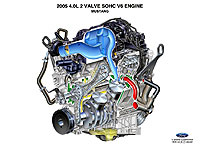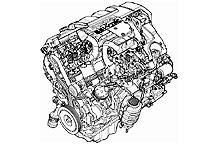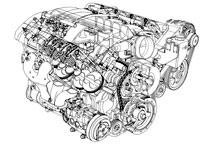Today, most engines feature either a single overhead camshaft (SOHC) or, more likely, a double overhead camshaft (DOHC). In a SOHC engine, the camshaft is located directly above the valves in the cylinder head and act directly in the valve stems to open and close the valves. The camshaft is driven by the crankshaft using a long rubber belt or steel chain. With DOHCs, sometimes called a "twin Cam," two overhead camshafts are used, one for the intake valves and second for the exhaust valves. In a V6 or V8 engine, two SOHCs or DOHCs are used, one for each bank of cylinders.

Engines with four or more valves per cylinder usually are DOHCs because you cannot fit enough cam lobes to actuate 12, 16, or 24 valves on a single camshaft. More valves mean better breathing - that is, intake and exhaust gases can flow more freely because there are more openings - and thus more power came be made from the same engine displacement or size.
The toothed belts on SOHC and DOHC engines need to be replaced periodically. If a timing belt breaks, the camshaft will stop turning and the results could be disastrous. Serious damage can also result if the belt loses of some of its teeth or ratchets excessively.
There are two types of overhead camshaft designs, free-running or interference, based on what happen if a belt or chain breaks and the proper synchronization between the piston and valve is lost. With the free-running, or free-wheeling, even though the valves and pistons are running “out of sync“, there is still enough clearance between the valve and piston, even if the cam stops with a valve fully open. In contrast, in an interference design, a valve can collide with a piston. This can result in a bent valve stem, hole in a piston top, damaged cylinder head or a completely destroyed engine. Today’s high compression, emission-controlled are more likely to be of the interference type.

Rather than risk being stranded on the side of the road, or worse, an expensive engine repair bill, carefully heed the advice of the auto manufacturers. Timing belts should be replaced at the time or mileage interval specified in your owner's manuals, typically 60,000, 80,000 or 100,000 miles. To be doubly safe, the belt should be inspected at between 30,000 and 50,000 miles. The most practical time to check the belt is during a tune-up, while the spark plugs are out and there is no engine compression so the engine can be rotated quite easily. Unless, you are more than the average shade tree mechanic, inspection and replacement of belts should be left to the professionals, the consequences of doing things wrong are too expensive. If dirt, coolant or oil has entered the timing belt cover, the chances for belt failure are greatly increased. Inspection and if required, replacement, should be done as soon as possible. Don’t forget to find the source of the leak and repair it.
Chain camshaft drives are more expensive to manufacture, but usually last the life of the engine. They are usually found on more expensive and high performance cars, but because they are narrower than timing belts, more manufacturers are using them in today’s more compact engines. While, they don’t usually need replacement, many do need periodic adjustment, so read your owner’s manual. Usually, a chain will start to make noises long before it will do any damage to the engine.
American automakers stuck with overhead valve (OHV) designs, also called a "pushrod" design, longer than the Europeans or Japanese. Indeed, GM is still using pushrod engines and have been able to develop OHV designs that still can match, or even out perform, the best SOHCs and DOHCs. The most notable example is the LS7 V8 in the 2006 Corvette Z06. The 7-liter pushrod engine pumps out 505-horsepower at 6000 rpm in the fastest production car GM has ever built and showed that OHV can be high revving engines provide SOHC and DOHCs advocates wrong.

In an OHV engine the camshaft is located in the engine block while the valves are located in the cylinder head above the combustion chambers. Pushrods are long rods that go up through the block and into the head to move the rocker arms that in turn move the valves. The camshaft in a pushrod engine is often driven by gears or a short chain that are generally far less prone to breakage or other damage compared to belt drives.




